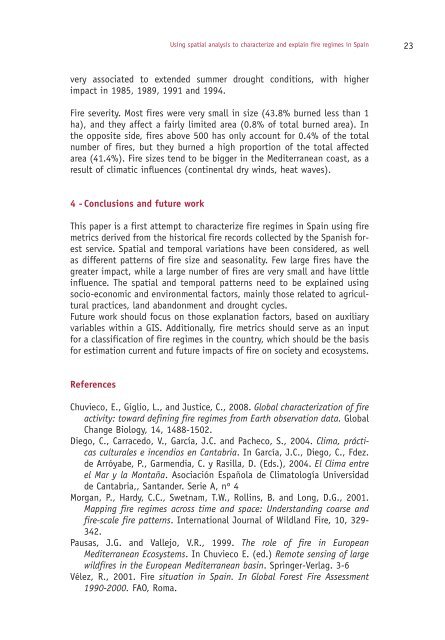7th Workshop on Forest Fire Management - EARSeL, European ...
7th Workshop on Forest Fire Management - EARSeL, European ...
7th Workshop on Forest Fire Management - EARSeL, European ...
Create successful ePaper yourself
Turn your PDF publications into a flip-book with our unique Google optimized e-Paper software.
Using spatial analysis to characterize and explain fire regimes in Spain 23<br />
very associated to extended summer drought c<strong>on</strong>diti<strong>on</strong>s, with higher<br />
impact in 1985, 1989, 1991 and 1994.<br />
<strong>Fire</strong> severity. Most fires were very small in size (43.8% burned less than 1<br />
ha), and they affect a fairly limited area (0.8% of total burned area). In<br />
the opposite side, fires above 500 has <strong>on</strong>ly account for 0.4% of the total<br />
number of fires, but they burned a high proporti<strong>on</strong> of the total affected<br />
area (41.4%). <strong>Fire</strong> sizes tend to be bigger in the Mediterranean coast, as a<br />
result of climatic influences (c<strong>on</strong>tinental dry winds, heat waves).<br />
4 - C<strong>on</strong>clusi<strong>on</strong>s and future work<br />
This paper is a first attempt to characterize fire regimes in Spain using fire<br />
metrics derived from the historical fire records collected by the Spanish forest<br />
service. Spatial and temporal variati<strong>on</strong>s have been c<strong>on</strong>sidered, as well<br />
as different patterns of fire size and seas<strong>on</strong>ality. Few large fires have the<br />
greater impact, while a large number of fires are very small and have little<br />
influence. The spatial and temporal patterns need to be explained using<br />
socio-ec<strong>on</strong>omic and envir<strong>on</strong>mental factors, mainly those related to agricultural<br />
practices, land aband<strong>on</strong>ment and drought cycles.<br />
Future work should focus <strong>on</strong> those explanati<strong>on</strong> factors, based <strong>on</strong> auxiliary<br />
variables within a GIS. Additi<strong>on</strong>ally, fire metrics should serve as an input<br />
for a classificati<strong>on</strong> of fire regimes in the country, which should be the basis<br />
for estimati<strong>on</strong> current and future impacts of fire <strong>on</strong> society and ecosystems.<br />
References<br />
Chuvieco, E., Giglio, L., and Justice, C., 2008. Global characterizati<strong>on</strong> of fire<br />
activity: toward defining fire regimes from Earth observati<strong>on</strong> data. Global<br />
Change Biology, 14, 1488-1502.<br />
Diego, C., Carracedo, V., García, J.C. and Pacheco, S., 2004. Clima, prácticas<br />
culturales e incendios en Cantabria. In García, J.C., Diego, C., Fdez.<br />
de Arróyabe, P., Garmendia, C. y Rasilla, D. (Eds.), 2004. El Clima entre<br />
el Mar y la M<strong>on</strong>taña. Asociación Española de Climatología Universidad<br />
de Cantabria,, Santander. Serie A, nº 4<br />
Morgan, P., Hardy, C.C., Swetnam, T.W., Rollins, B. and L<strong>on</strong>g, D.G., 2001.<br />
Mapping fire regimes across time and space: Understanding coarse and<br />
fire-scale fire patterns. Internati<strong>on</strong>al Journal of Wildland <strong>Fire</strong>, 10, 329-<br />
342.<br />
Pausas, J.G. and Vallejo, V.R., 1999. The role of fire in <strong>European</strong><br />
Mediterranean Ecosystems. In Chuvieco E. (ed.) Remote sensing of large<br />
wildfires in the <strong>European</strong> Mediterranean basin. Springer-Verlag. 3-6<br />
Vélez, R., 2001. <strong>Fire</strong> situati<strong>on</strong> in Spain. In Global <strong>Forest</strong> <strong>Fire</strong> Assessment<br />
1990-2000. FAO, Roma.
















